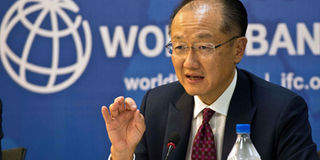World Bank President arrives for crucial visit

World Bank president Jim Yong Kim gestures while addressing a press conference in India's capital New Delhi on July 23, 2014. Kim arrives in Nairobi on October 28, 2014 for a high level visit aimed at strengthening cooperation for peace, security and development in the Horn of Africa. FILE PHOTO | AFP
What you need to know:
- Kim visits the country at a time when Kenyans are optimistic about prospects for better growth and equity driven by devolution and discovery of oil.
- Kenya is East Africa’s largest economy and a key partner in the World Bank Group’s strategy of ending global poverty and increasing shared prosperity.
World Bank Group President Jim Yong Kim arrives in Nairobi on Tuesday for a high level visit aimed at strengthening cooperation for peace, security and development in the Horn of Africa.
Kim, and United Nations Secretary-General, Ban Ki-moon, will meet President Uhuru Kenyatta and later private sector representatives to talk about regional integration and economic opportunities for countries in the region.
Kim visits the country at a time when Kenyans are optimistic about prospects for better growth and equity driven by devolution and discovery of oil.
The nation moved to lower middle-income status following re-basing of the Gross Domestic Product last month. However, vulnerability due to rising insecurity in the Horn of Africa remains a serious challenge.
TERRORISM
Tourism, a major foreign exchange earner, has slumped due to terrorism while high unemployment among the youth is yet to be dealt with fully.
Kenya is East Africa’s largest economy and a key partner in the World Bank Group’s strategy of ending global poverty and increasing shared prosperity.
Under its new country partnership strategy, the bank group projects to invest a total of $4 billion mainly through the International Development Association (IDA), the IFC and the Multilateral Investment Guarantee Agency (Miga).
The strategy focuses on three core areas of engagement.
They are competitiveness and sustainability, protecting the vulnerable and helping them to develop their potential, and decentralising power and public services to promote greater equity and long term consistency of public services.
IDA, IFC and Miga are collaborating closely to strengthen development outcomes and impact on beneficiaries.
The current IDA portfolio amounts to $4.7 billion in 24 national projects ($3.8 billion) and seven regional projects ($900 million).
New commitments of $484.2 million was delivered and an estimated $565 million will be available next year.




